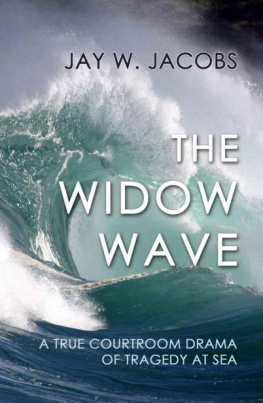THE
WIDOW
WAVE
A True Courtroom Drama
of Tragedy at Sea
Jay W. Jacobs

Q UID P RO B OOKS
New Orleans, Louisiana
Smashwords edition. Copyright 2014 by Jay W. Jacobs. No part of this book may be reproduced by any mechanical, photographic, or electronic process, or other recording, nor may it be stored in a retrieval system, transmitted, or otherwise copied for public or private use other than for fair use without the written permission of the publisher. Please respect the intellectual property of the author.
Published in 2014 by Quid Pro Books, at Smashwords.
ISBN 978-1-61027-263-6 (ebk)
ISBN 978-1-61027-262-9 (pbk)
ISBN 978-1-61027-273-5 (hbk)
QUID PRO BOOKS
Quid Pro, LLC
5860 Citrus Blvd., suite D-101
New Orleans, Louisiana 70123
www.quidprobooks.com
qp
Publishers Cataloging-in-Publication
Jacobs, Jay W.
The widow wave: a true courtroom drama of tragedy at sea / Jay W. Jacobs.
p. cm.
ISBN 978-1-61027-263-6 (ePUB ebook edition)
1. Jacobs, Jay W.Trials, litigation, etc. 2. CaliforniaTrials, litigation, etc. 3. Boating accidentsTrials, litigation, etc. I. Title.
KD378.C45.J82 2014
812'.31.5dc22
2014431789
Front cover image adapted from photograph by Mana Photo, used by permission. Author photograph provided courtesy of Marsha Jacobs.
C ONTENTS
For
Three strong women in my life
My wife Marsha
My mother Elizabeth
Janet Dowd
I Owe You All So Much
There are no roses
on a sailors grave,
no lilies
on an ocean wave.
The only tributes
are the seagulls sweep,
and the teardrops that
the sweetheart
weeps.
Anonymous
A Note to the Reader
A number of years have passed since the events in this true story occurred concerning the worst recreational fishing boat accident that ever happened in San Francisco, and the subsequent trial. When I decided to write this story, the trial transcript was no longer available. In preparation for writing, I reviewed the court clerks file, interviewed some of the people involved, revisited many of the locations, and conducted research. The following reference works were referred to: the United States Coast Pilot, various charts, tide and current logs, the Coast Guard report concerning the disappearance of the Aloha , documents from the National Weather Service, the Coroners office autopsy report, and what remained of my case file, memoranda and notes.
Much of the book is in dialogue form. Words stated within quotation marks are reconstructed from my memory. While not word for word, they are the substance of what was said, and I believe them to be a true and accurate reconstruction.
The feelings and emotions I describe in others are as I remember and interpret them. While I make no claim of omniscience, I believe that feelings such as joy, fear, anger, love and frustration are capable of almost universal understanding. Where such feelings and reactions in others are stated, they are my interpretations, unless otherwise noted.
The parts of the story where I attempt to portray what may have happened to the boat, and what the men onboard may have done, are based on my conversations with boat operators, experts in the fields of oceanography, meteorology, and navigation, and my own experiences at sea.
The
Widow
Wave
I N THE entire case, the only fact that everyone involved agreed on was this: at some point during his long flight from Manila to San Francisco, H. Tho Ang flew right over the beginnings of the storm that, a few days later, would take his life. It would be the worst recreational fishing boat accident ever to happen in San Franciscos long maritime history.
If Mr. Ang had looked out through his window to the ocean below, nothing would have aroused a premonition of danger. The winds churning the oceans surface into a mass of white-capped waves scarcely seem ominous when viewed from 39,000 feet.
As the plane flew eastward across the Pacific, a meteorological reaction of major proportion was rapidly evolving. Two different and very dangerous air masses had converged and were interacting. A fast moving accumulation of frigid air, which originated in the Siberian Arctic, was hurtling toward a swirling mass of unusually warm tropical air that had been hovering over the Central Pacific for weeks. The two weather fronts collided 1,500 miles northeast of Hawaii... a ticking meteorological time bomb that would explode a few days later.
Acting like Davids sling, the storms violently spinning epicenter would hurl the thirty and forty foot waves it created toward the California coast, two thousand miles away.
Cruising in the calm air of the upper atmosphere, the airliner was completely unaffected by the events taking place on the oceans surface. For all the effect it had on the plane, the storm brewing below could just as easily have been occurring on another planet.
Omiyakon is a remote village located in the vast drainage basin of the Lena River in far eastern Siberia. Winter begins in September, and does not relinquish its icy grip until May, nine long months later. The brief summer is from June to August. There is no spring or fall .
Despite its tiny size and isolated location near the Arctic Circle, Omiyakon has a unique characteristic differentiating it from any other place: it is the coldest inhabited place on earth. One year the thermometer dropped to a world record low temperature of minus 90 degrees below zero.
The extreme cold makes the Lena basin one of the most inhospitable places on the planet. In the dead of winter, the words below and zero always seem to be used together.
Omiyakons residents seldom venture out alone; a breakdown on a deserted track could be fatal. At zero degrees Fahrenheit, frostbite attacks exposed skin in fifteen minutes. At minus 40, water begins to freeze in a matter of seconds, and at minus 60, steel can shatter like glass.
In this brutally cold environment there is one unexpected element of beauty: at exceptionally low temperatures a deep breath expelled into the bone dry arctic air freezes instantly, forming miniature ice crystals that make a tinkling sound as they float downwards.
The Lena basin has one other distinction not noted in any record book. Despite its unbelievable frigidness, the basin is the birthplace of some of the earths most catastrophic storms; not the arctic blizzards one would expect... but major tropical storms.
Every winter the mountain ranges surrounding the basin trap huge masses of bitterly cold arctic air. The impounded air builds to a point where the mountains can no longer contain it. Propelled by the arctic jet stream, the massed air begins to flow over the mountain crests, taking it thousands of miles southeastwards toward the tropical air in the mid-Pacific. This phenomenon of fast moving arctic air is referred to by meteorologists as the Siberian Express.
When a significant drop in temperature occurs in an area the size of the Lena basin, the collected weight of billions of compacted air molecules results in a substantial increase in barometric pressure.
Two weeks before Mr. Angs flight, masses of cold arctic air had blanketed the Lena basin, raising the barometric pressure to an unusually high 30.59 pounds per square inch. North of Hawaii, just the opposite effect was taking place. The heat of the sun expanded the air molecules, dropping the barometric pressure to 28.99 psi. When the icy arctic air converged with the mass of swirling tropical air, its warmth pulled the cold air into its vortex like a spiders mating dance.










